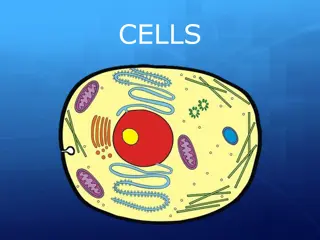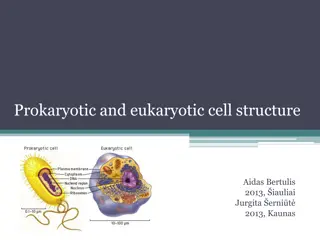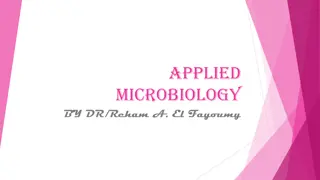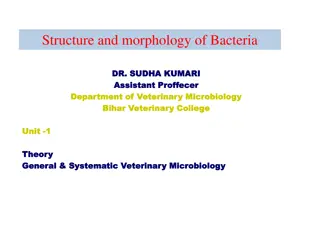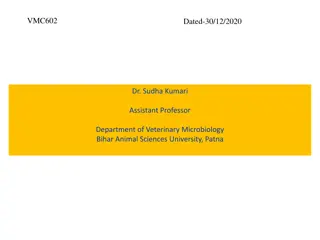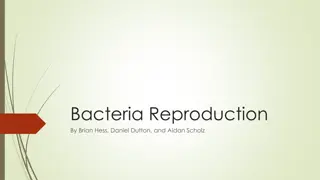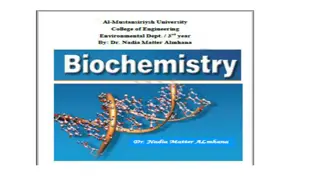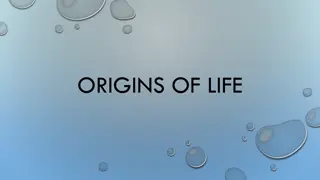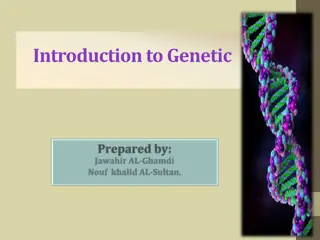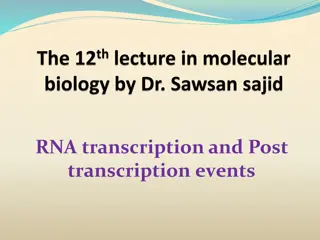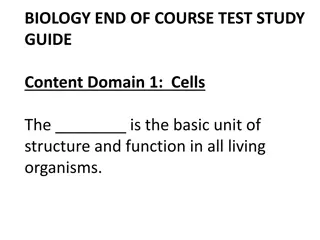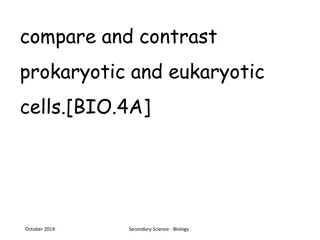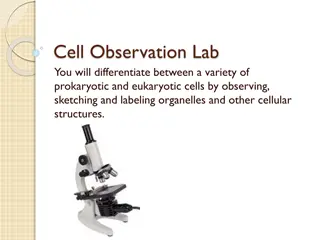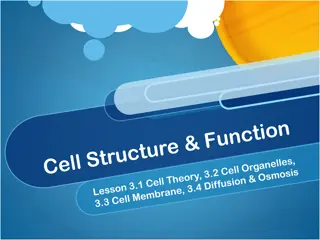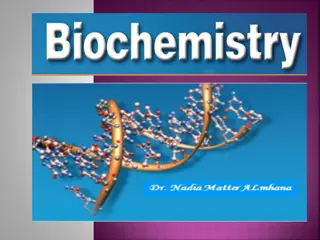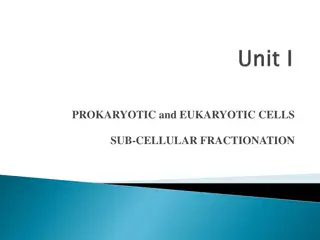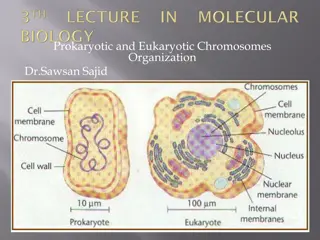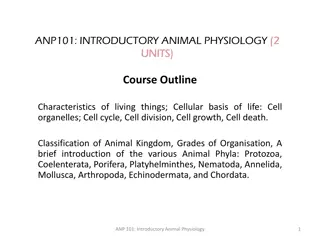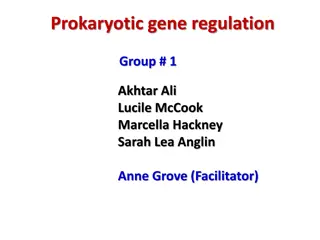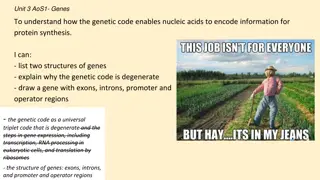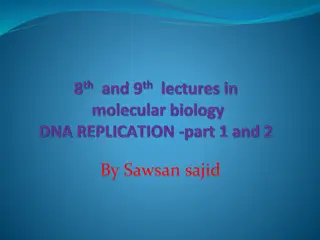Understanding Gene Editing with CRISPR/Cas9 Technology
Explore the fascinating world of CRISPR/Cas9 gene editing technology through sessions led by experts like Roy Campbell and Howard Robinson. Delve into the working of gene editing, the CRISPR system, and the role of Cas9 enzyme. Learn about CRISPR's origin in prokaryotic organisms and its potential f
0 views • 33 slides
Understanding Cell Reproduction and the Cell Cycle
Explore the process of cell reproduction, DNA structure, chromosomes, and the differences between prokaryotic and eukaryotic cell cycles. Learn about binary fission, mitosis, and cytokinesis in the context of cellular growth and division. Understand the significance of genes, DNA organization into c
5 views • 56 slides
CELLS
Discover the incredible world of cells in the human body, each playing a vital role in sustaining life. Explore the diversity of cell types, learn about the history of microscopy, and delve into the Cell Theory. Understand the differences between prokaryotic and eukaryotic cells, essential building
1 views • 69 slides
Understanding Prokaryotic and Eukaryotic Cell Structure
This comprehensive guide explores the structures and characteristics of prokaryotic and eukaryotic cells. Learn about the differences and similarities between these cell types, including features like cell wall composition, membrane-bound organelles, nucleus presence, DNA structure, ribosomes, and m
7 views • 20 slides
Understanding Applied Microbiology: Insights into Microbial Diversity and Cell Organization
Applied Microbiology focuses on harnessing the capabilities of microorganisms for the production of beneficial products like medicines, vaccines, and biotechnological advancements. This field explores the intricate interactions between prokaryotic and eukaryotic organisms, emphasizing their pivotal
0 views • 23 slides
Overview of Bacterial Structure and Morphology in Veterinary Microbiology
Bacteria are single-celled prokaryotic organisms with a simple body design. Their structure includes layers such as the extramural layer, surface appendages like flagella and pili, cell envelop with a cell wall and cytoplasmic membrane, and cytoplasmic inclusions. The capsule and slime layer play es
0 views • 21 slides
An Overview of Cell Biology: From Cytology to Modern Studies
Cell biology, also known as cytology, explores cells from various perspectives including physiological, developmental, and evolutionary aspects. Modern Cell Biology delves into the mechanisms of metabolism, heredity, and evolution at the molecular level, involving proteins, RNAs, and DNA. The compar
0 views • 13 slides
Exploring the Thermophilic Organisms: Thermoplasma Genus
The Thermoplasma genus belongs to Archaea and thrives in acidic, high-temperature environments. These prokaryotic organisms lack a defined nucleus and utilize sulfur and organic carbon for respiration. They possess a unique membrane composition, allowing them to survive in extreme conditions. Specie
0 views • 12 slides
Cell Structure and Function: A Comprehensive Overview
Delve into the world of cells, exploring the distinct features of animal and plant cells, the differences between prokaryotic and eukaryotic cells, the significance of organelles, and the fascinating processes such as stem cell differentiation and cell adaptation. Discover how substances move across
0 views • 5 slides
Insights into Bacteria Reproduction and Cell Division
Explore the fascinating world of bacteria reproduction through binary fission, conjugation, and mitosis. Uncover the similarities and unique aspects of prokaryotic and eukaryotic cell division processes. Learn how conjugation plays a vital role in transferring genetic information between bacteria ce
0 views • 21 slides
Understanding the Molecular Composition of Living Cells
Living cells are primarily composed of hydrogen, oxygen, nitrogen, carbon, phosphorus, and sulfur, which form the basis of organic biomolecules. Cells have common features such as cytoplasm, cell membranes, and nuclei. Different types of cells exist, ranging from eukaryotic with organized nuclei to
0 views • 9 slides
Understanding Bacteria: Classification and Characteristics Explained
Explore the world of bacteria with details on their shapes, structures, classifications into Eubacteria and Archaebacteria, differences between the two domains, and the classification based on characteristics like shape, cell wall makeup, energy source, and reproduction. Discover the fascinating rea
0 views • 45 slides
Understanding Unicellular and Multicellular Organisms in Biology
Explore the basic differences between unicellular and multicellular organisms, including the distinctions between prokaryotes and eukaryotes. Unicellular organisms, such as bacteria and amoeba, consist of a single cell and are often microscopic. Examples of both prokaryotic and eukaryotic unicellula
0 views • 10 slides
Evolutionary Journey: From Spontaneous Generation to Endosymbiont Theory
Explore the fascinating evolution of life from early beliefs in spontaneous generation to the modern Miller-Urey experiments demonstrating simple organic molecule formation. Learn about the transition to biogenesis theory, cellular evolution, and the groundbreaking endosymbiont theory proposed by Ly
1 views • 9 slides
An Overview of Genetics and Cellular Components
Explore the fundamental concepts of genetics, including cell types, genetic material, heredity, and genetic terminology. Learn about prokaryotic and eukaryotic cells, chromosomes, DNA, genes, and the study of heredity. Discover the significance of genetic information stored in the nucleus and its ro
0 views • 13 slides
Overview of Cell Division in Prokaryotes and Eukaryotic Cells
Cell division plays a crucial role in the growth and reproduction of all organisms. In prokaryotic cells, binary fission is the primary mode of division, while eukaryotic cells undergo a more complex process involving cell growth, DNA replication, chromosome distribution, and cytokinesis. The cell c
0 views • 10 slides
Differences Between DNA Replication and RNA Transcription
This content discusses the general variances between DNA replication and RNA transcription, highlighting their purposes, processes, enzymes involved, timing, and more. It delves into the initiation, template, and involved areas of replication and transcription, as well as key DNA regions like promot
0 views • 24 slides
Exploring Molecular Biology and Cell Science
Molecular biology delves into the study of biology at the molecular level, focusing on gene structure and functions to comprehend hereditary traits, genetic variation, and gene expression patterns. Cells, the fundamental units of life, vary in shape and function but share basic structures. The Three
0 views • 31 slides
Comparison of Eukaryotic and Prokaryotic Cells in Cell Biology
Cells are the fundamental units of life, but viruses are an exception as they lack cells. Eukaryotic cells have a defined nucleus with a nuclear membrane housing chromosomes, while prokaryotic cells lack a membrane-bound nucleus and other organelles. Eukaryotic cells are larger, containing membrane-
0 views • 9 slides
Cell Division Mechanisms in Prokaryotic and Eukaryotic Cells
Prokaryotic cells divide through binary fission, while eukaryotic cells undergo mitosis with nuclear division and cytokinesis. Prokaryotic cells lack a nucleus and divide by replicating DNA and forming two identical daughter cells. Eukaryotic chromosomes, associated with histone proteins, undergo co
0 views • 56 slides
Understanding Cells: The Basic Units of Life
Exploring the fundamental importance of cells in living organisms, this study guide delves into the structure and function of eukaryotic and prokaryotic cells. It highlights the distinction between these cell types, their respective characteristics, and the defining features of living things. Emphas
0 views • 93 slides
Exploring Cellular Biology: From Cells to DNA
Delve into the intricacies of cellular biology by comparing prokaryotic and eukaryotic cells, investigating cellular processes, understanding viral structures and reproduction, exploring the cell cycle stages, examining specialized cells, and recognizing the crucial roles of DNA and RNA in cell diff
0 views • 42 slides
Cell Observation Lab for Prokaryotic and Eukaryotic Cells
Explore the differences between prokaryotic and eukaryotic cells through a hands-on lab. Observe, sketch, and label organelles in bacteria (yogurt), protists (pond water), fungi (yeast), and plant cells (onion and anacharis). Learn to differentiate cellular structures and understand the characterist
0 views • 17 slides
Understanding Cells: Structure, Function, and Evolution
Explore the world of cells, the basic units of life, from their structure and function to the history of cell theory. Learn about prokaryotic and eukaryotic cells, the cytoskeleton, and key organelles. Dive into differences between animal and plant cells and the critical role of chloroplasts in ener
0 views • 28 slides
Understanding DNA Structure and Genetic Information Encoding
Complementary nitrogenous bases in DNA, pyrimidines (thymine, cytosine) and purines (adenine, guanine), store biological information through antiparallel strands. DNA, with non-coding regions, undergoes replication and transcription to RNA for protein synthesis. Nucleic acids, DNA, and RNA are cruci
0 views • 7 slides
Prokaryotic and Eukaryotic Cells: A Comparative Overview
Prokaryotic cells are simpler and lack membrane-bound organelles, reproducing through binary fission. Eukaryotic cells are more complex, larger, with a nucleus enclosed in a nuclear envelope. They have various organelles and a cell wall. The plasma membrane defines cell boundaries, regulating the pa
0 views • 13 slides
Understanding Prokaryotic and Eukaryotic Chromosome Organization
Chromosomes are vital structures in cells, holding genetic material. Prokaryotic cells have a nucleoid containing DNA while eukaryotic cells have DNA enclosed in a nucleus. Proteins like H-NS, HU, FIS, and IHF play crucial roles in maintaining chromosome structure and gene expression. Unlike eukaryo
0 views • 20 slides
Introduction to Animal Physiology and Cellular Biology Overview
This comprehensive course delves into the fundamental aspects of animal physiology and cellular biology. Topics covered include the characteristics of living organisms, cellular organelles, the cell cycle, division, growth, and death. Additionally, the course introduces the various animal phyla, fro
0 views • 43 slides
Understanding Prokaryotic Gene Regulation: A Teachable Unit
Dive into the world of prokaryotic gene regulation with a focus on the lac operon. This educational unit aims to help students comprehend the mechanisms behind gene regulation, specifically through the example of the lac operon. Explore key terms, models, and outcomes to enhance understanding in an
0 views • 30 slides
Understanding Genes and the Genetic Code for Protein Synthesis
Explore the structures of genes, the degeneracy of the genetic code, and the process of protein synthesis through transcription, RNA processing, and translation. Delve into the role of exons, introns, promoters, and operators in gene expression in eukaryotic cells. Learn why the genetic code is dege
0 views • 13 slides
Cellular Compartmentalization Unit in Biology Course
This unit focuses on cellular compartmentalization in cells, targeting second-year students in intro biology or microbiology courses. Students explore structural and functional differences between prokaryotic and eukaryotic cells through learning goals and an engaging alien mystery experiment from V
0 views • 25 slides
Understanding DNA Replication: From Basics to Lab Synthesis
DNA replication is a fundamental process in all living organisms, essential for biological inheritance. This comprehensive guide explores the stages of DNA replication, highlighting key experiments and differences between prokaryotic and eukaryotic replication. Additionally, it delves into the revol
1 views • 31 slides


